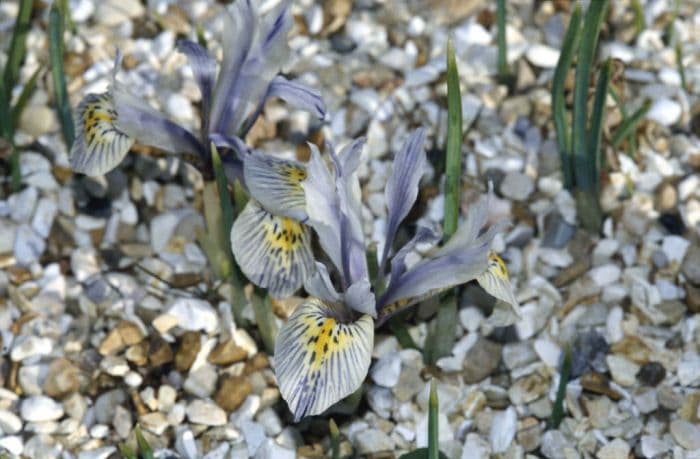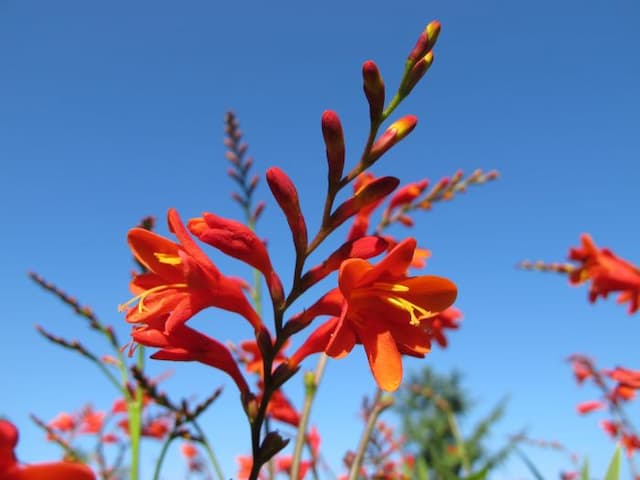Katharine Hodgkin Iris Iris 'Katharine Hodgkin' (Reticulata)

ABOUT
Iris 'Katharine Hodgkin' is a captivating and distinctive plant known for its ornamental flowers, which are prized by garden enthusiasts. The blooms possess a unique beauty characterized by their soft, pale blue or icy blue petals that blend seamlessly into richer, deeper blue shades. Each flower has an intricate pattern with streaks and spots of yellow and greenish tones, accentuated by deeper blue or purple veining. This marbling effect creates an almost ethereal appearance. The petals have a delicate texture, with the standards— or the upright segments of the bloom—in a lighter hue, contrasting with the falls—the lower, drooping segments—that display a bolder coloration and a gentle ruffle at their edges. The sword-like foliage of Iris 'Katharine Hodgkin' is slender and upright, adding an architectural quality to the plant's overall form. The leaves are a fresh, rich green color, which provides a striking backdrop to the luminous blooms that emerge in the early spring, drawing the eye and signaling the end of winter with their vivid display. With its enchanting flowers and elegant foliage, Iris 'Katharine Hodgkin' is a cherished addition to any garden, conveying an exotic charm and a touch of classic elegance that belies its hardy and robust nature, making it as resilient as it is beautiful.
About this plant
 Names
NamesFamily
Iridaceae
Synonyms
Katherine Hodgkin Iris, Hodgkin's Iris, Dwarf Iris, Reticulated Iris
Common names
Iris 'Katharine Hodgkin' (Reticulata).
 Toxicity
ToxicityTo humans
The plant commonly known as Katharine Hodgkin Iris is not highly toxic to humans. However, all parts of the plant, especially the rhizomes (underground stems), contain mild to moderate amounts of irritating substances that can cause an upset stomach if ingested in large quantities. Contact with the sap can also cause skin irritation in sensitive individuals. The typical symptoms of ingestion can include nausea, vomiting, abdominal pain, and diarrhea. Handling the plant may result in skin irritation, so it is advisable to wear gloves when working with it.
To pets
The Katharine Hodgkin Iris is considered mildly toxic to pets, such as dogs and cats. If a pet were to ingest parts of this plant, particularly the rhizomes, they could experience symptoms such as gastrointestinal upset, evident by vomiting, diarrhea, drooling, or loss of appetite. While it is unlikely to be life-threatening, it is still important to prevent pets from ingesting the plant, and if they do, to monitor for any adverse reactions. If a pet exhibits severe symptoms or a large quantity of the plant has been consumed, it is advisable to contact a veterinarian.
 Characteristics
CharacteristicsLife cycle
Perennials
Foliage type
Deciduous
Color of leaves
Green
Flower color
Mixed
Height
4-6 inches (10-15 cm)
Spread
3 inches (7.5 cm)
Plant type
Bulb
Hardiness zones
5
Native area
Western Asia
Benefits
 General Benefits
General Benefits- Early Spring Bloom: Iris 'Katharine Hodgkin' is known for its early spring flowers, adding color to the garden when many other plants are dormant.
- Aesthetic Appeal: With its distinctive blue, yellow, and white patterned petals, it provides striking visual interest and enhances the beauty of any landscape.
- Attracts Pollinators: This Iris variety attracts bees and other pollinators which are vital for the pollination of many plants.
- Low Maintenance: It is a low maintenance plant that requires minimal care once established, making it ideal for gardeners of all skill levels.
- Drought Tolerance: Once established, it has good drought tolerance, reducing the need for frequent watering.
- Compact Size: The compact size of Iris 'Katharine Hodgkin' makes it suitable for small gardens, borders, rock gardens, or container planting.
- Naturalizing: It has the ability to naturalize, or spread, over time, creating a fuller, more robust garden display.
 Medical Properties
Medical PropertiesThis plant is not used for medical purposes.
 Air-purifying Qualities
Air-purifying QualitiesThis plant is not specifically known for air purifying qualities.
 Other Uses
Other Uses- Iris 'Katharine Hodgkin' bulbs can be crushed and used as a natural pest repellent in gardens due to their strong scent which some pests find off-putting.
- The plant's fibrous leaves can be woven into small artisanal crafts such as baskets or decorative mats.
- The stems of Iris 'Katharine Hodgkin' can be used in floral arrangements to add an interesting vertical element, especially when the flowers are not in bloom.
- Petals of the Iris 'Katharine Hodgkin' can be used as a natural dye in textiles, giving a soft blue or pale yellow hue depending on the mordant used.
- Pressed Iris 'Katharine Hodgkin' flowers can be used in art projects like herbariums or botanical collages for their intricate patterns and colors.
- The sap extracted from the stems and leaves can act as a mild adhesive in traditional crafts and bookbinding.
- Fragrance from the flowers can be used to make potpourri, which can serve as a natural air freshener for small spaces.
- Dried petals from the Iris 'Katharine Hodgkin' can be infused into oils to create fragrant soaps and candles.
- When dried, the seed pods can be used as a subtle natural rattling sound in musical instruments or children's toys.
- The plant can serve as a teaching tool for botany enthusiasts to learn about unique hybridization processes and plant characteristics.
Interesting Facts
 Feng Shui
Feng ShuiThe Iris is not used in Feng Shui practice.
 Zodiac Sign Compitability
Zodiac Sign CompitabilityThe Iris is not used in astrology practice.
 Plant Symbolism
Plant Symbolism- Faith: Iris 'Katharine Hodgkin' often symbolizes faith, representing belief and trust in oneself and others.
- Hope: The plant is also associated with hope, indicating the anticipation of something positive or the belief in a good outcome.
- Wisdom: Irises are often connected to wisdom, reflecting intelligence and the ability to make sound decisions.
- Purity: The clean, striking appearance of the Iris 'Katharine Hodgkin' can symbolize purity and innocence.
- Courage: In some cultures, the iris symbolizes courage, as it stands tall and proud, boldly displaying its beauty.
- Royalty: The majestic appearance of the flower has made it a symbol of royalty and an emblem for kings and queens throughout history.
 Water
WaterKatharine Hodgkin Iris, commonly known as the Reticulata Iris, should be watered moderately. During the growing season, keep the soil consistently moist but never waterlogged. Water the plant thoroughly once a week, providing about one gallon of water per session for a regular-sized garden plant. It's crucial to reduce watering after the blooming period as the plant enters dormancy; during this time, watering every 2-3 weeks is sufficient. Ensure that the soil has good drainage to prevent root rot.
 Light
LightThe Katharine Hodgkin Iris thrives best in full sunlight to partial shade. It should be placed in a spot that receives at least six hours of direct sunlight per day. However, in regions with very intense sun, some afternoon shade is beneficial to prevent scorching of the leaves. This iris can also tolerate light dappled shade, particularly in hotter climates.
 Temperature
TemperatureThe Katharine Hodgkin Iris prefers temperate conditions and is hardy in zones 5 through 9. It can survive winter temperatures down to 5°F and is comfortable during the growing season in temperatures ranging between 60°F and 75°F. However, it should be protected from extreme heat, as temperatures consistently above 90°F may adversely affect the plant.
 Pruning
PruningPruning the Katharine Hodgkin Iris is mainly for aesthetic purposes and to remove spent blooms. After flowering, cut back the flower stalk to the base of the plant to encourage tidy growth. In late summer or fall, when leaves yellow, trim the foliage down to ground level. Pruning is usually done annually to prevent diseases and pests and to maintain plant health.
 Cleaning
CleaningAs needed
 Soil
SoilKatherine Hodgkin Iris prefers well-draining soil with a slightly acidic to neutral pH level of 6.0 to 7.0. A mix composed of two-thirds loam and one-third perlite or grit ensures good drainage. During the growing season, incorporate organic matter like leaf mold to enhance soil fertility and structure.
 Repotting
RepottingKatherine Hodgkin Iris, being a bulbous plant, does not require frequent repotting. It should be lifted and divided every three to five years after blooming when the clumps become congested, typically in late summer.
 Humidity & Misting
Humidity & MistingKatherine Hodgkin Iris tolerates average outdoor humidity levels well. As it is primarily grown outdoors, the typical garden humidity range is suitable, and it does not require any special humidity considerations outside of natural conditions.
 Suitable locations
Suitable locationsIndoor
Place in bright light, cooler temp, and well-draining soil.
Outdoor
Plant in well-drained soil, full sun to partial shade.
Hardiness zone
5-9 USDA
 Life cycle
Life cycleIris 'Katharine Hodgkin' begins its life cycle as a bulb, which is typically planted in the fall, lying dormant in the soil through winter until the proper conditions for growth are met. In late winter to early spring, the plant breaks dormancy, sending up leaves and a flower stalk, with the unique pale blue to yellow flowers blooming from late winter to early spring. After flowering, the foliage continues to photosynthesize and store energy in the bulb for the next season. Once the leaves die back in late spring or early summer, the plant enters a period of dormancy during the warmer months. The bulbs may divide, creating offsets that can be separated and replanted to propagate the plant. Each year, the cycle repeats with the bulb re-sprouting in the following season, carrying on the succession of growth, flowering, and dormancy.
 Propogation
PropogationPropogation time
Late Summer
The most popular method of propagation for the Iris 'Katharine Hodgkin', commonly known as the Dwarf Iris, is by dividing its bulbs. This process is ideally done in late summer, after the foliage has died back, and the bulbs have entered a dormant period. To propagate, gently lift the clumps of bulbs from the ground using a spade or fork and carefully separate the offsets from the parent bulb. These offsets are miniature bulbs that form at the base of the parent bulb. Replant the offsets at a depth of approximately 3 to 4 inches (7.5 to 10 centimeters) and space them about 3 inches (7.5 centimeters) apart in well-draining, fertile soil with plenty of sunlight. Ensure that the pointy end of the bulb is facing upwards. Water thoroughly after planting to establish the bulbs in their new location.







![Montbretia [Little Redhead]](/_next/image?url=https%3A%2F%2Fplants-admin.emdemapps.com%2Fimages%2Fplants%2F%2Fimages%2F604b5635373f8.png&w=640&q=75)

